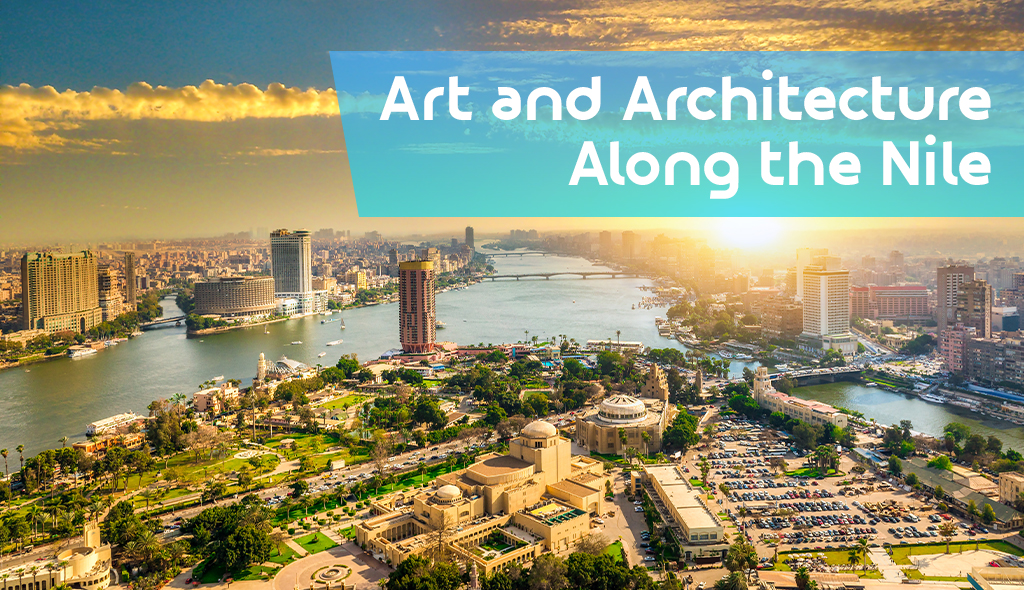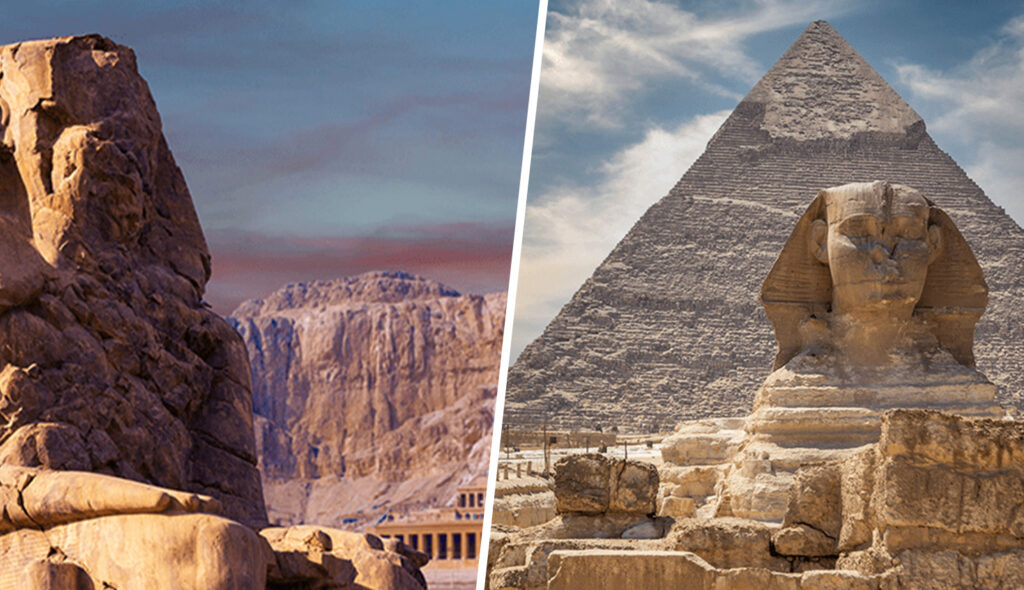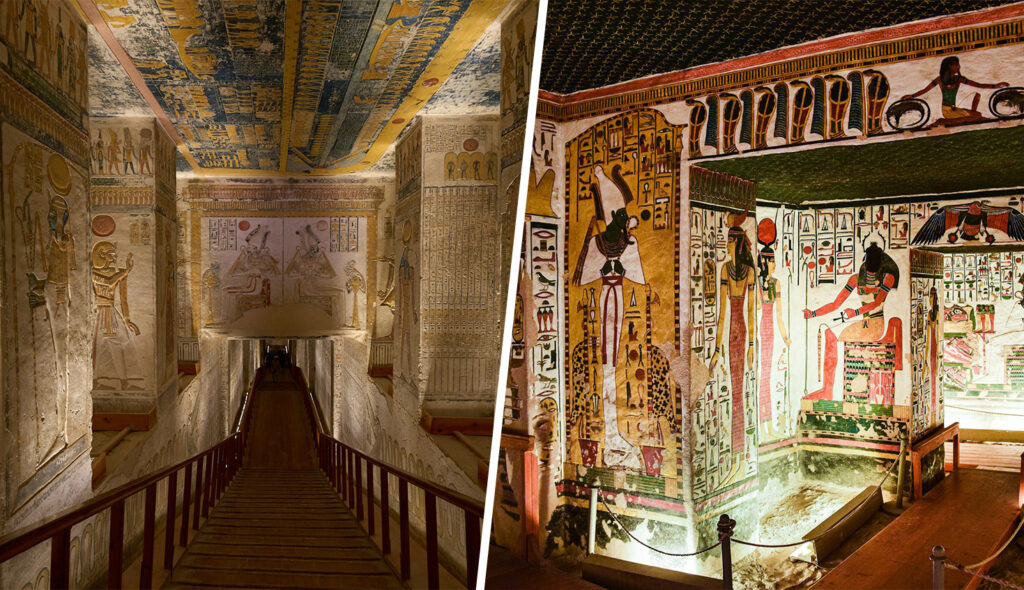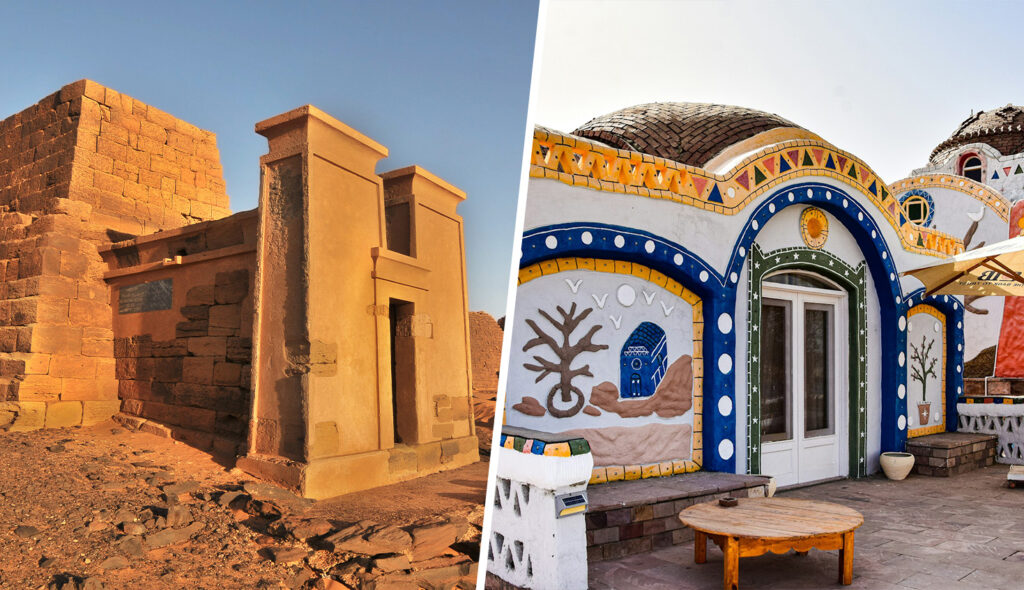Journey Along The Nile: The Evolution Of Egyptian Art And Architecture Unveiled
30 August 2024

The Nile River has profoundly influenced Egyptian art and architecture, consequently impacting its culture. The Great Waterway has been an inspiration source for all Egyptian artists since ancient times, ranging from temple designs to complex wall paintings.
Egyptian art and architecture along the Nile have been characterised by riverine themes and agricultural motifs that underscored its role in shaping ancient Egyptian civilisation. These artworks represent how vital this river was in sustaining life and symbolise fertility accompanied by abundance. Furthermore, recurring features such as papyrus plants, lotus flowers, and marine creatures in images made it even more vivid that the Nile was directly linked to their daily life and religion.
Ancient Egyptian symbolism frequently drew upon the Nile’s annual flood cycle, crucial for agriculture and prosperity. The river became personified through Gods and Goddesses whose statues ornamented temple walls and other monumental structures. Most importantly, the presence of the river also determined where many essential buildings would be situated, such as the temples or tombs constructed along its banks.
Those who want to go on a Nile Cruise 2025 holiday should opt for Travelodeal packages. These cruises allow people to have a firsthand experience of what has remained from ancient times. They help understand how far back in history the river shaped Egypt’s art through magnificent structures still present today.

Marvels of Ancient Engineering
Egyptian art and architecture along the Nile are evidence of how creative early humans were. To this day, modern architects need help understanding how the Great Pyramids could have been built with such accuracy while relying only on human effort. This engineering feat continues to amaze even though no cranes or bulldozers have been used when constructing these giant towers.
Another example of architectural significance is the Sphinx, which is placed on the Giza plateau. Its lion body bears a human head. Farther down south lies Luxor Temple, an impressive piece of religious architecture. Its massive pillars and detailed hieroglyphics provide information regarding the nature of Egyptian beliefs and their artistic skills.
The Karnak Temple Complex and Abu Simbel also show the architectural styles of the era. These are tourist sites for people on Nile Cruises, which have potent statues and highly carved walls illustrating stories of Pharaohs and Gods. The scale of the temples suggests their religious importance and the extent to which their art was precise.
Egyptian art and architecture along the Nile serve as a glimpse into the past and continue to influence modern design and engineering principles. The pharaonic monuments, such as the pyramids’ precise alignment and temple decorations’ intricate beauty, also represent timeless human accomplishments and creativity.

Artistic Expressions Along the Nile
Egyptian art and architecture along the Nile have been intriguing for years because they give insight into Egypt’s ancient cultural heritage. Majestic sculptures, statues, and intricate tomb paintings with reliefs representing everyday life in the afterlife are, among other things, on display here, making them awe-inspiring.
One of Egyptian art’s most recognisable aspects is its elaborate wall reliefs and paintings in tombs or temples. These vibrant depictions provide essential information on ancient Egyptian society, religion, beliefs, practices, etc., while burial objects like elaborate coffins, canopic jars, and amulets address specific ideas about death rituals.
Another example is that Egyptians created beautiful jewellery using precious metals and intricately designed gemstones to demonstrate their working metal and cutting stone skills. Furthermore, they were often more than just fashion accessories with symbolic meanings due to religious beliefs.
Egyptian art and architecture along the Nile still fascinate today’s audiences who travel from different parts of the world. For those who wish to see them at close range, Travelodeal packages offer holidays through ancient Egypt with the all-inclusive Nile Cruise 2025. This allows travellers to gain deep knowledge about this great civilisation that has lived to this day.
Nile’s Influence on Egyptian Architectural Techniques
Egyptian art and architecture along the Nile have been profoundly influenced by the river, leading to unique design principles and innovative techniques. The use of symmetry to balance structures was inspired by the annual cycle of flooding in the Nile River. Flood-resistant buildings were made from mud-brick and limestone materials available on the riverbanks.
An essential architectural innovation is the development of columns and obelisks, whose designs sometimes borrowed much from various plants near the Nile. These elements served structural and symbolic purposes since they represented the earthly world meeting the divine one. Ancient Egyptian obelisks were crafted using advanced stone quarrying technology, showcasing the Egyptians’ engineering prowess.
Egyptian architecture has been influenced by water management systems such as nilometers, which measure or predict water levels in the River Nile. This illustrates how Egyptian art and architecture along the Nile adapted over time to use the river’s power. Mud-brick construction on homes contrasting with monumental stone temples and tombs illustrates how flexible Egyptian builders were about their natural surroundings.

Nubian Art and Architecture
The Nile is full of Nubian art and architecture, representing a unique cultural heritage besides the influence of Egyptian traditions. This can be traced to ancient times when notable structures and artefacts were found in the Nile Valley.
However, Nubian art had more natural human figures, lively colour schemes, and peculiar pottery. Moreover, it frequently used local symbols and motifs, in addition to hieroglyphs and some architectural forms that distinguished it from its Egyptian counterpart.
The Nile has several significant Nubian structures, such as massive temples and castles. The Kushite pyramids at Meroë, with their steeper sides and smaller bases compared to those seen on the Egyptian pyramids, are a testament to the skills of Nubian architects. Another example includes Gebel Barkal, which has temple ruins and palaces representing natural landmarks that were important landmarks for Nubian architecture.
Nubian pottery is famous for its complex red-orange designs, often with geometric patterns or animals. It sheds light on ancient Nubians’ life and religious convictions. Rock art scattered across the area reflects much about the lives and beliefs of people who lived there ages ago. Christianised Nubian art later appeared, incorporating traditional features within churches and monasteries with Christian Iconography.
Those wanting an experiential touch with this cultural heritage should consider embarking on the Egypt Nile Cruise holidays by Travelodeal Packages, which will provide both the exploration of historical sites and modern tourist facilities.
Blending Tradition with Innovation
Egyptian art and architecture along the Nile have undergone significant shifts, featuring ancient themes mixed with contemporary design ideas. Urban scenery today is characterised by these mixes that can be observed in paintings created by modern Egyptians also residing along this waterway. For millennia, the River Nile has served as Egypt’s lifeline; it remains a source of inspiration for its art and architecture.
Several contemporary landmarks exemplify this blend of tradition and innovation. The Aswan Dam, completed in 1970, epitomises Egypt’s technological advancement and the country’s ability to exploit the Nile’s resources. The Cairo Tower, with its latticed design inspired by ancient Egyptian motifs, offers a modern interpretation of traditional aesthetics. Perhaps the most striking example of this synthesis is the Bibliotheca Alexandrina, a reimagining of the ancient Library of Alexandria that combines cutting-edge design with references to Egypt’s rich cultural heritage.
Modern Egyptian designs still reflect Islamic architecture, which borrows from traditional architectural intricacies such as Mashrabiya screens and geometric patterns. Contemporary Egyptian artists continue to draw inspiration from the Nile and the country’s ancient past while exploring new mediums and techniques.
This art is often concerned with issues surrounding identity, shifts in societal aspects, and customs and traditions that oppose modernity. An ongoing discussion between the present and past keeps art in Egypt vibrant on river banks today.
Preserving Nile’s Artistic Legacy
Egyptian art and architecture along the Nile have enthralled the world for many years, a testimony to ancient civilisations’ ingenuity and cultural wealth. Nonetheless, maintaining this artistic legacy presents multiple challenges in contemporary times.
- Climate change is one of the greatest threats several Nile monuments face since it accelerates erosion and decay through rising water levels and increased humidity.
- Mass tourism has also taken a toll, with fragile structures and artefacts suffering wear and tear.
Nonetheless, some restoration projects are currently underway to preserve these treasures that, once lost, cannot be replaced. International collaborations have been beneficial in preserving UNESCO World Heritage Sites along the Nile, including Luxor and Karnak Temples. The efforts aim to protect these physical structures, but they also include documenting artefacts in digital forms for future generations.
Preserving cultural heritage sites is not just about preserving them but also extends to their surrounding landscape and local communities. Striking a balance between tourism revenue and sustainable preservation remains a significant challenge. For instance, new technologies like 3D scanners or virtual reality provide visitors with immersive experiences while limiting physical strain on sites.
Suppose we want to see Egyptian art and architecture along the Nile persist in the days ahead. In that case, continued collaboration between local authorities, international organisations, and the global community should be maintained. Addressing these challenges directly will help instigate fresh opportunities for conservation, thus ensuring that they continue inspiring awe across generations.
Egyptian art and architecture along the Nile still mesmerises tourists from all over the globe. The timeless aesthetics of these works represent a tribute to the skills and creative power of ancient Egyptians. At present, people have an opportunity to discover this heritage while visiting a large number of historical sites situated along the Nile banks.
Cruising the Nile is the best way to experience the richness of Egyptian artistry and architectural brilliance in their everlasting glory. Plan your journey now, visit Travelodeal UK for Nile Cruise Egypt packages, and explore Egypt’s wonders as they unfold alongside the life-giving waters of the Nile.
Frequently Asked Questions (FAQs)
What is the best time to take a Nile Cruise?
The ideal period would be between October and April when it is less hot than other months, but you can still go for it anytime during the year.
What should I pack for a Nile Cruise?
Lightweight, conservative clothes, comfortable walking shoes, a hat, sun cream, insect repellent, and a camera are essential items in your luggage before boarding a ship on this longest river.
What are the major attractions of a Nile Cruise?
The temples of Luxor, Karnak Temple, Valley of the Kings, Edfu Temple, and Aswan High Dam are among the typical stops.
Are there any age restrictions for Nile Cruises?
Though not age-specific, some trips may be too challenging for young children or those with physical limitations.
What kind of accommodation should I expect?
Cabins come in various forms, from standard rooms to luxury suites, primarily en-suite and air-conditioned.







